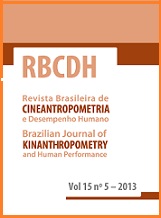Educação física escolar, atividade desportiva e atividade física total em adolescentes
DOI:
https://doi.org/10.1590/1980-0037.2013v15n5p517Resumen
Menos da metade dos adolescentes atingem a recomendação de 300 minutos por semana de Atividade Física (AF). As aulas de Educação Física e participação de esporte proporcionam oportunidades para os adolescentes acumularem mais tempo para a prática de AF, entretanto, pouco se sabe sobre a influência dessas variáveis no nível de AF total dos adolescentes. O objetivo do estudo foi verificar a associação entre a prática de Educação Física Escolar (EFE) e Atividades Desportivas (AD) com a prática deAF total em adolescentes. O estudo foi transversal e participaram 467 adolescentes do Ensino Médio (15,8 ± 0,9 anos) da cidade de Rio Claro-SP. Os participantes preencheram o Physical Activity Questionnaire to Older Children (PAQ-C) e questões relacionadas com a prática de EFE e AD. Foi realizada a Regressão Logística com p<0,05 através do SPSS. Meninas apresentaram menor prevalência de AF do que os meninos, 9,4% e 26,8% respectivamente. Meninos que não realizaram EFE (RO=0,25; IC95%= 0,09-0,66) e AD na escola (RO=0,34;IC95%=0,12-0,95) apresentaram menores chances de serem ativos na AF total do que os meninos que praticaram essas atividades. A participação das aulas de EFE ou a prática de alguma AD foram associadas positivamente com a prática de AF total nos meninos.
Descargas
Publicado
Número
Sección
Licencia

Direitos Autorais para artigos publicados nesta revista são do autor, com direitos de primeira publicação para a revista. Em virtude da aparecerem nesta revista de acesso público, os artigos são de uso gratuito, com atribuições próprias, em aplicações educacionais e não-comerciais, desde que seja dada a atribuição. Esta obra foi licenciada com uma Licença Creative Commons Atribuição 4.0 Internacional - CC BY


